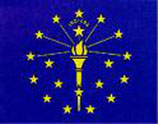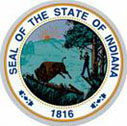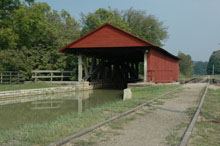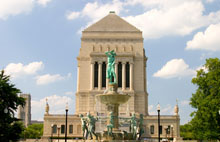About Indiana
Indiana is located in the Midwest region of the United States. Indiana is a diverse state with a few large urban areas and a number of smaller industrial cities. It is best known for the Indianapolis 500 American automobile race, held annually over the Memorial Day weekend. Residents of Indiana are called Hoosiers. Indiana is bounded on the north by Lake Michigan and the state of Michigan; on the east by Ohio; on the south by Kentucky, with which it shares the Ohio River as a border; and on the west by Illinois. Indiana is one of the Great Lakes states.
Most of Indiana has a humid continental climate, with the extreme southern portions of the state bordering on a humid subtropical climate. This means the state has four well defined seasons with warm to hot summers and cool to cold winters. Summertime maximum temperatures average around 85°F with cooler nights around 60°F. Winters are a little more variable, but generally cool to cold temperatures with all but the northern part of the state averaging above freezing for the maximum January temperature, and the minimum temperature below 20°F for most of the state. The state receives a good amount of precipitation, 40 inches annually statewide, in all four seasons, with March through August being slightly wetter.
The area of Indiana has been settled since before the development of the Hopewell culture (ca. 100–400 CE). The area was claimed for New France in the 17th century, handed over to the Kingdom of Great Britain as part of the settlement at the end of the French and Indian War, given to the United States after the American Revolution, soon after which it became part of the Northwest Territory, then the Indiana Territory, and joined the Union in 1816 as the 19th state.
A high percentage of Indiana’s income is from manufacturing. The Calumet region of northwest Indiana is the largest steel producing area in the U.S., and this activity also requires that very large amounts of electric power be generated. Indiana’s other manufactures include automobiles, electrical equipment, transportation equipment, chemical products, rubber, petroleum and coal products, and factory machinery. The state is located within the Corn Belt and the state’s agricultural methods and principal farm outputs reflect this: a feedlot-style system raising corn to fatten hogs and cattle. Soybeans are also a major cash crop. Its proximity to large urban centers, such as Chicago, assure that dairying, egg production, and specialty horticulture occur.
Indiana is home to the international headquarters of pharmaceutical company Eli Lilly as well as the headquarters of Mead Johnson Nutritionals, a division of Bristol-Myers Squibb. Elkhart, in the north, has also had a strong economic base of pharmaceuticals, though this has changed over the past decade with the closure of Whitehall Laboratories in the 1990s and the planned drawdown of the large Bayer complex, announced in late 2005. Indiana’s economy is considered to be one of the most business-friendly in the U.S. This is due in part to its conservative business climate, low business taxes, and many labor laws that have remained unchanged since the 1800s, emphasizing the supremacy of employer/management. The doctrine of at-will employment, whereby an employer can terminate an employee for any or no reason, is in force. Unions in Indiana are among the weakest in the U.S. and it is difficult for unions to organize.
Indiana annually ships over 70 million tons of cargo by water each year, which ranks 14th among all U.S. states. More than half of Indiana’s border is water, which includes 400 miles of direct access to two major freight transportation arteries: the Great Lakes/St. Lawrence Seaway (via Lake Michigan) and the Inland Waterway System (via the Ohio River).
$state_id = ‘IN’ ;
global $state_id ;
[/insert_php]
[insert_php]
$state_id = ‘IN’ ;
[/insert_php]








